Real-Time Scanning Curve of Soil–Water Characteristic Curve for Sustainability of Residual Soil Slopes
Abstract
1. Introduction
2. Site Overview and Field Instrumentation
3. Research Methodology
3.1. Applicable Theory
3.2. Laboratory Testing
4. Results
4.1. Experimental Results
4.1.1. Basic Soil Properties
4.1.2. Soil–Water Characteristic Curve
4.1.3. Pore Size Distribution
4.2. Field Instrumentation Results
5. Discussion
5.1. Influence of Rainfall on the Soil Moisture and Soil Suction of the Slope
5.2. Scanning Curve of Soil–Water Characteristic Curve
6. Conclusions
Author Contributions
Funding
Institutional Review Board Statement
Informed Consent Statement
Data Availability Statement
Acknowledgments
Conflicts of Interest
References
- Udemba, E.N.; Khan, N.U.; Raza Shah, S.A. Demographic change effect on ecological footprint: A tripartite study of urbanization, aging population, and environmental mitigation technology. J. Clean. Prod. 2024, 437, 140406. [Google Scholar] [CrossRef]
- Henderson, J.V.; Jang, B.Y.; Storeygard, A.; Weil, D.N. Climate Change, Population Growth, and Population Pressure; NBER Working Paper Series; National Bureau of Economic Research: Cambridge, MA, USA, 2024; Available online: http://www.nber.org/papers/w32145 (accessed on 1 January 2025).
- Strauch, A.M.; MacKenzie, R.A.; Giardina, C.P.; Bruland, G.L. Climate driven changes to rainfall and streamflow patterns in a model tropical island hydrological system. J. Hydrol. 2015, 523, 160–169. [Google Scholar] [CrossRef]
- Liu, W.; Bai, R.; Sun, X.; Yang, F.; Zhai, W.; Su, X. Rainfall-and Irrigation-Induced Landslide Mechanisms in Loess Slopes: An Experimental Investigation in Lanzhou, China. Atmosphere 2024, 15, 162. [Google Scholar] [CrossRef]
- Satyanaga, A.; Mohammad, A.S.; Ibrahimi, A.B.; Wijaya, M.; Moon, S.; Kim, J. Direct and indirect methods in determination of water retention curve of residual soils. In Proceedings of the 17th Asian Regional Conference on Soil Mechanics and Geotechnical Engineering (17th ARC), Astana, Kazakhstan, 14–18 August 2023; CRC Press: Boca Raton, FL, USA, 2023; pp. 363–371. [Google Scholar] [CrossRef]
- Leung, A.K.; Sun, H.W.; Millis, S.W.; Pappin, J.W.; Ng, C.W.; Wong, H.N. Field monitoring of an unsaturated saprolitic hillslope. Can. Geotech. J. 2011, 48, 339–353. [Google Scholar] [CrossRef]
- Greco, R.; Guida, A.; Damiano, E.; Olivares, L. Soil water content and suction monitoring in model slopes for shallow flowslides early warning applications. Phys. Chem. Earth 2010, 35, 127–136. [Google Scholar] [CrossRef]
- Dikshit, A.; Sarkar, R.; Pradhan, B.; Segoni, S.; Alamri, A.M. Rainfall induced landslide studies in indian himalayan region: A critical review. Appl. Sci. 2020, 10, 2466. [Google Scholar] [CrossRef]
- Askrinejad, A.; Casini, F.; Bischof, P.; Beck, A.; Springman, S. Rainfall induced instabilities: A field experiment on a silty sand slope in northern Switzerland. Riv. Ital. Di Geotec. 2012, 3, 50–71. [Google Scholar]
- Kawagoe, S.; Kazama, S.; Sarukkalige, P.R. Assessment of snowmelt triggered landslide hazard and risk in Japan. Cold Reg. Sci. Technol. 2009, 58, 120–129. [Google Scholar] [CrossRef]
- Chiarelli, D.D.; Galizzi, M.; Bocchiola, D.; Rosso, R.; Rulli, M.C. Modeling snowmelt influence on shallow landslides in Tartano valley, Italian Alps. Sci. Total Environ. 2023, 856, 158772. [Google Scholar] [CrossRef]
- Miao, F.; Wu, Y.; Li, L.; Liao, K.; Zhang, L. Risk assessment of snowmelt-induced landslides based on GIS and an effective snowmelt model. Nat. Hazards 2019, 97, 1151–1173. [Google Scholar] [CrossRef]
- Jia, X.; Jiang, X.; Huang, J.; Yu, S.; Liu, B. Slope Stability Analysis Based on the Explicit Smoothed Particle Finite Element Method. Sustainability 2024, 16, 702. [Google Scholar] [CrossRef]
- Fredlund, D.G.; Rahardjo, H.; Fredlund, M.D. Unsaturated Soil Mechanics in Engineering Practice; John Wiley & Sons: Hoboken, NJ, USA, 2012. [Google Scholar] [CrossRef]
- Vanapalli, S.K.; Catana, M.C. Estimation of the soil-water characteristic curve of coarse-grained soils using one point measurement and simple properties. In Proceedings of the International Symposium on Advanced Experimental Unsaturated Soil Mechanics, Trento, Italy, 27–29 June 2005; pp. 401–410. [Google Scholar]
- Tao, G.; Peng, Y.; Liu, Y. A method for predicting unsaturated soil permeability coefficient based on clay content. Fractals 2023, 31, 2340177. [Google Scholar] [CrossRef]
- Chai, J.; Khaimook, P. Prediction of soil-water characteristic curves using basic soil properties. Transp. Geotech. 2020, 22, 100295. [Google Scholar] [CrossRef]
- Ren, X.; Kang, J.; Ren, J.; Chen, X.; Zhang, M. A method for estimating soil water characteristic curve with limited experimental data. Geoderma 2020, 360, 114013. [Google Scholar] [CrossRef]
- Pernebekova, G.; Satyanaga, A.; Abishev, R.; Moon, S.; Kim, J. Water characteristic curve and permeability function of steel slag. In Proceedings of the 17th Asian Regional Conference on Soil Mechanics and Geotechnical Engineering (17th ARC), Astana, Kazakhstan, 14–18 August 2023; CRC Press: Boca Raton, FL, USA, 2023; pp. 523–527. [Google Scholar] [CrossRef]
- Satyanaga, A.; Wijaya, M.; Hamdany, A.H.; Moon, S.-W.; Kim, J. Green retaining structure utilizing recycled concrete aggregate. In Sustainable Materials in Civil Infrastructure; Woodhead Publishing: Cambridge, UK, 2024; pp. 151–160. [Google Scholar] [CrossRef]
- Leão, T.P.; Domingues Da Costa, B.F.; Bof Bufon, V.; Fidel, F.; Aragón, H. Using time domain reflectometry to estimate water content of three soil orders under savanna in Brazil. Geoderma Reg. 2020, 21, e00280. [Google Scholar] [CrossRef]
- He, H.; Turner, N.C.; Aogu, K.; Dyck, M.; Feng, H.; Si, B.; Wang, J.; Lv, J. Time and frequency domain reflectometry for the measurement of tree stem water content: A review, evaluation, and future perspectives. Agric. For Meteorol. 2021, 306, 108442. [Google Scholar] [CrossRef]
- Royer, J.M.; Vachaud, G. Field Determination of Hysteresis in Soil-Water Characteristics. Soil Sci. Soc. Am. J. 1975, 39, 221–223. [Google Scholar] [CrossRef]
- Chen, Y.; Li, B.; Xu, Y.; Zhao, Y.; Xu, J. Field Study on the Soil Water Characteristics of Shallow Layers on Red Clay Slopes and Its Application in Stability Analysis. Arab J. Sci. Eng. 2019, 44, 5107–5116. [Google Scholar] [CrossRef]
- Pham, H.Q.; Fredlund, D.G.; Barbour, S.L. A study of hysteresis models for soil-water characteristic curves. Can. Geotech. J. 2005, 42, 1548–1568. [Google Scholar] [CrossRef]
- Li, A.G.; Tham, L.G.; Yue, Z.Q.; Lee, C.F.; Law, K.T. Comparison of field and laboratory soil–water characteristic curves. J. Geotech. Geoenviron. Eng. 2005, 131, 1176–1180. [Google Scholar] [CrossRef]
- Hedayati, M.; Ahmed, A.; Hossain, M.S.; Hossain, J.; Sapkota, A. Evaluation and comparison of in-situ soil water characteristics curve with laboratory SWCC curve. Transp. Geotech. 2020, 23, 100351. [Google Scholar] [CrossRef]
- Metrological Service Singapore. Annual Climate Assessment Report; Metrological Service Singapore: Singapore, 2020. [Google Scholar]
- PWD. Geology of the Republic of Singapore; Public Works Department: Singapore, 1976. [Google Scholar]
- Barnes, G. Soil Mechanics Principles and Practice 2016, 4th ed.; Red Globe Limited: Kolkata, India, 2016. [Google Scholar]
- Brooks, R.H.; Corey, A.T. Hydraulic Properties of Porous Media; Hydrology Paper No. 3; Colorado State University: Fort Collins, CO, USA, 1964. [Google Scholar]
- Gardner, W.R. Some steady state solutions of the unsaturated moisture flow equation with application to evaporation from a water table. Soil Sci. 1958, 85, 228–232. [Google Scholar] [CrossRef]
- McKee, C.R.; Bumb, A.C. The importance of unsaturated flow parameters in designing a monitoring system for hazardous wastes and environmental emergencies. In Proceedings of the Hazardous Materials Control Research Institute National Conference, Houston, TX, USA, 4–6 March 1984; pp. 50–58. [Google Scholar]
- van Genuchten, M.T. A closed-form equation for predicting the hydraulic conductivity of unsaturated soils. Soil Sci. Soc. Am. J. 1980, 44, 892–898. [Google Scholar] [CrossRef]
- Fredlund, D.G.; Xing, A. Equations for the soil-water characteristic curve. Can. Geotech. J. 1994, 31, 521–532. [Google Scholar] [CrossRef]
- Satyanaga, A.; Kim, J.; Moon, S.W.; Wijaya, M. Exponential functions for modelling hysteresis of soil-water characteristic curves. E3S Web Comf. 2020, 195, 2002. [Google Scholar] [CrossRef]
- ASTM D6836-02; Standard Test Methods for Determination of the Soil Water Characteristic Curve for Desorption Using Hanging Column, Pressure Extractor, Chilled Mirror Hygrometer, or Centrifuge. ASTM International: West Conshohocken, PA, USA, 2008. [CrossRef]
- ASTM D2487-17; Standard Practice for Classification of Soils for Engineering Purposes (Unified Soil Classification System). ASTM International: West Conshohocken, PA, USA, 2017. [CrossRef]
- ASTM D422-63; Standard Test Method for Particle-Size Analysis of Soils. ASTM International: West Conshohocken, PA, USA, 2007. [CrossRef]
- ASTM D4318-17e1; Standard Test Methods for Liquid Limit, Plastic Limit, and Plasticity Index of Soils. ASTM International: West Conshohocken, PA, USA, 2017. [CrossRef]
- ASTM D5084-24; Standard Test Methods for Measurement of Hydraulic Conductivity of Saturated Porous Materials Using a Flexible Wall Permeameter. ASTM International: West Conshohocken, PA, USA, 2024. [CrossRef]
- Leong, E.C.; Rahardjo, H. Permeability functions for unsaturated soils. J. Geotech. Geoenviron. Eng. 1997, 123, 1118–1126. [Google Scholar] [CrossRef]
- Soil Moisture Equipment Corp. 2710 ARL Tensiometer and 2725ARL Jet Fill Tensiometer Operating Instructions; Soil Moisture Equipment Corp.: Goleta, CA, USA, 2011. [Google Scholar]
- Leung, A.K.; Garg, A.; Ng, C.W.W. Effects of plant roots on soil-water retention and induced suction in vegetated soil. Eng. Geol. 2015, 193, 183–197. [Google Scholar] [CrossRef]
- Ni, J.J.; Leung, A.K.; Ng, C.W.W.; So, P.S. Investigation of plant growth and transpiration-induced matric suction under mixed grass-tree conditions. Can. Geotech. J. 2017, 54, 561–573. [Google Scholar] [CrossRef]
- Carrick, S.; Buchan, G.; Almond, P.; Smith, N. Atypical early-time infiltration into a structured soil near field capacity: The dynamic interplay between sorptivity, hydrophobicity, and air encapsulation. Geoderma 2011, 160, 579–589. [Google Scholar] [CrossRef]
- Hou, X.; Qi, S.; Liu, F. Soil Water Retention and Pore Characteristics of Intact Loess Buried at Different Depths. Sustainability 2023, 15, 14890. [Google Scholar] [CrossRef]
- Bello, N.; Satyanaga, A.; Aventian, G.D.; Moon, S.-W.; Kim, J. Mathematical equations for modelling soil-water characteristic curve. In Smart Geotechnics for Smart Societies; CRC Press: Boca Raton, FL, USA, 2023; pp. 2378–2384. [Google Scholar]
- Horrocks, R.D.; Vallentine, J.F. 12—Water Relations and Irrigation. In Harvested Forages; Horrocks, R.D., Vallentine, J.F., Eds.; Academic Press: San Diego, CA, USA, 1999; pp. 225–242. [Google Scholar] [CrossRef]
- Resurreccion, A.C.; Moldrup, P.; Tuller, M.; Ferré, T.P.A.; Kawamoto, K.; Komatsu, T.; De Jonge, L.W. Relationship between specific surface area and the dry end of the water retention curve for soils with varying clay and organic carbon contents. Water Resour. Res. 2011, 47, 6. [Google Scholar] [CrossRef]
- Lu, N.; Likos, W.J. Suction stress characteristic curve for unsaturated soil. J. Geotech. Geoenviron. Eng. 2006, 132, 131–142. [Google Scholar] [CrossRef]

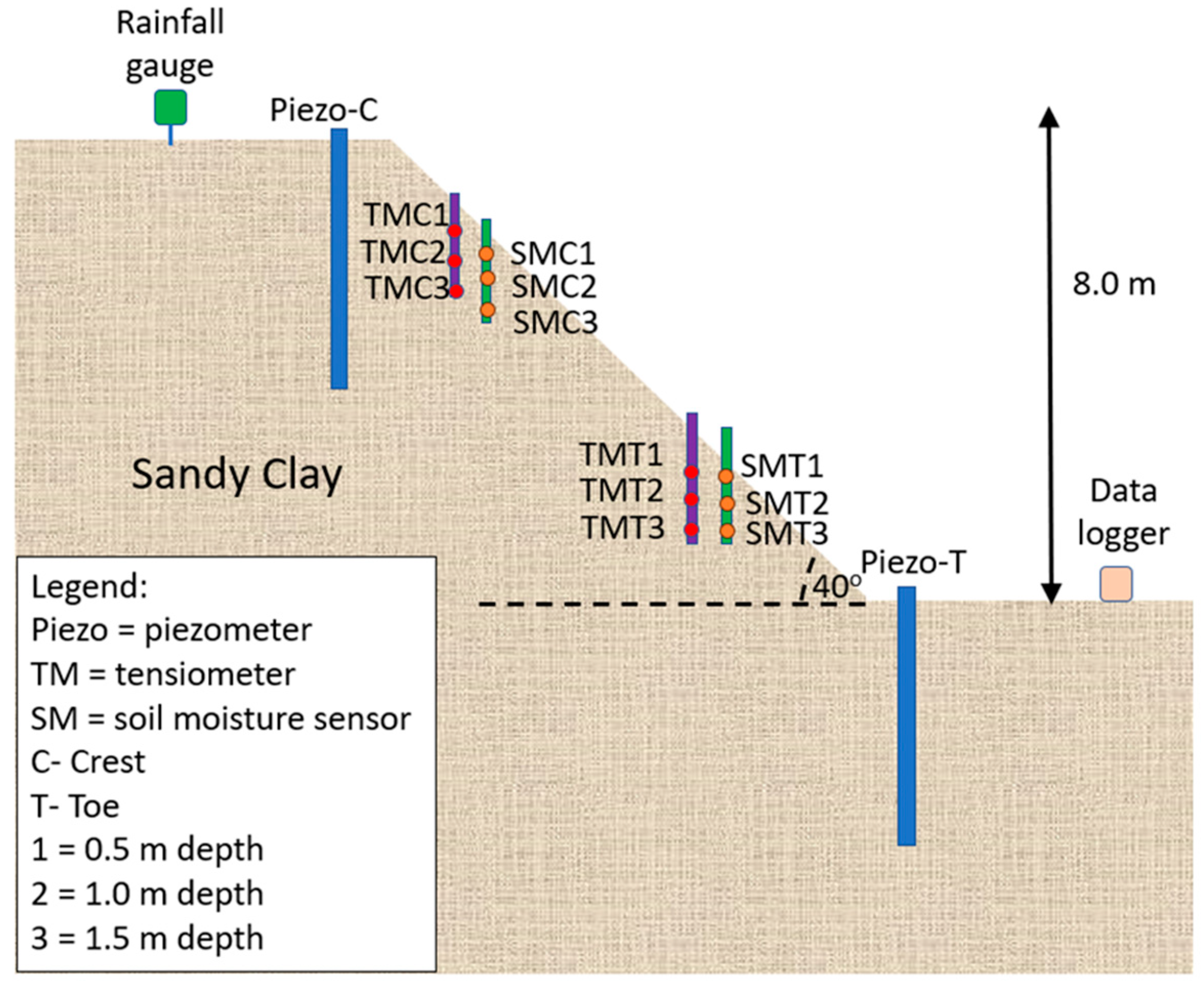

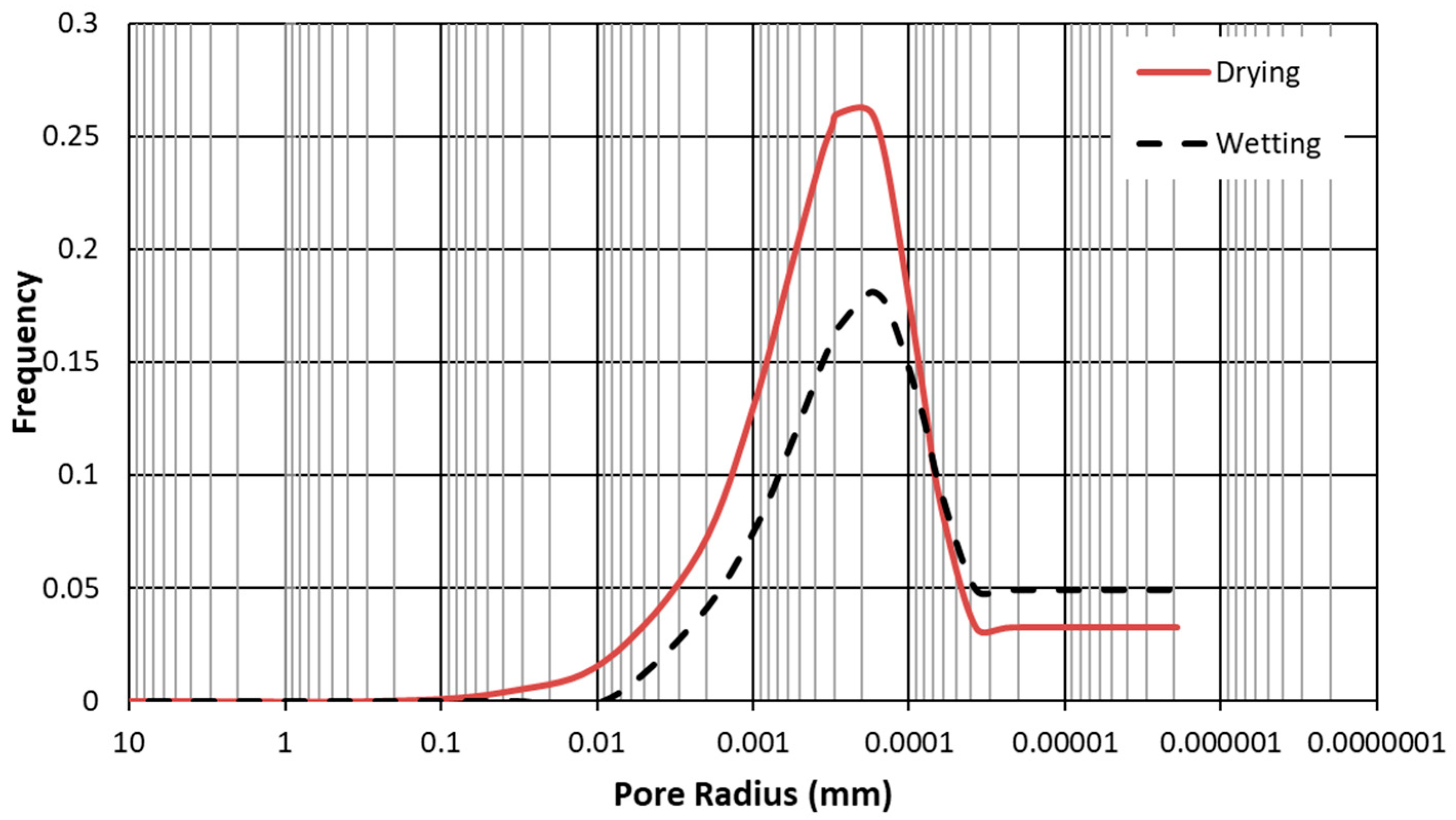

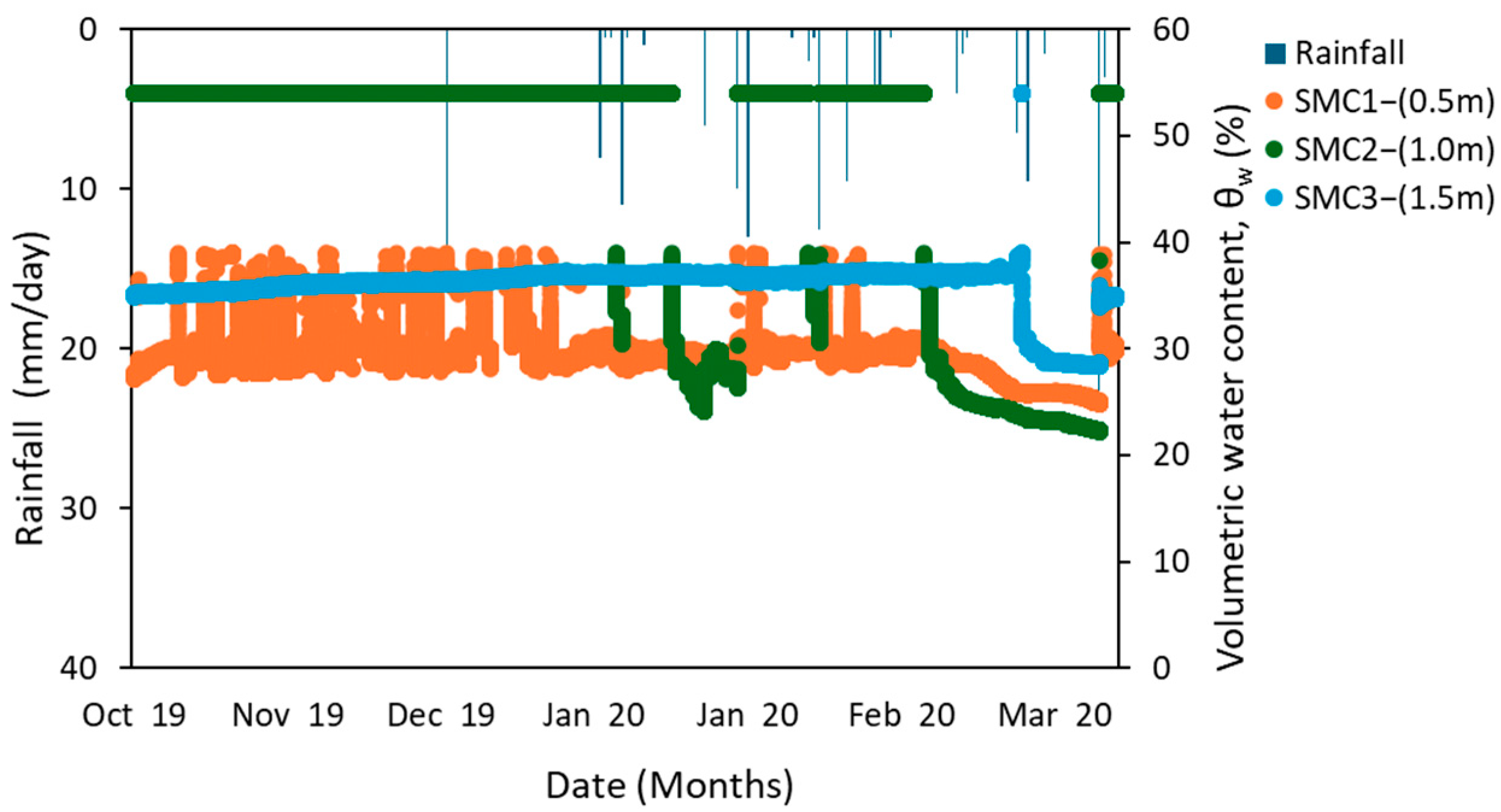
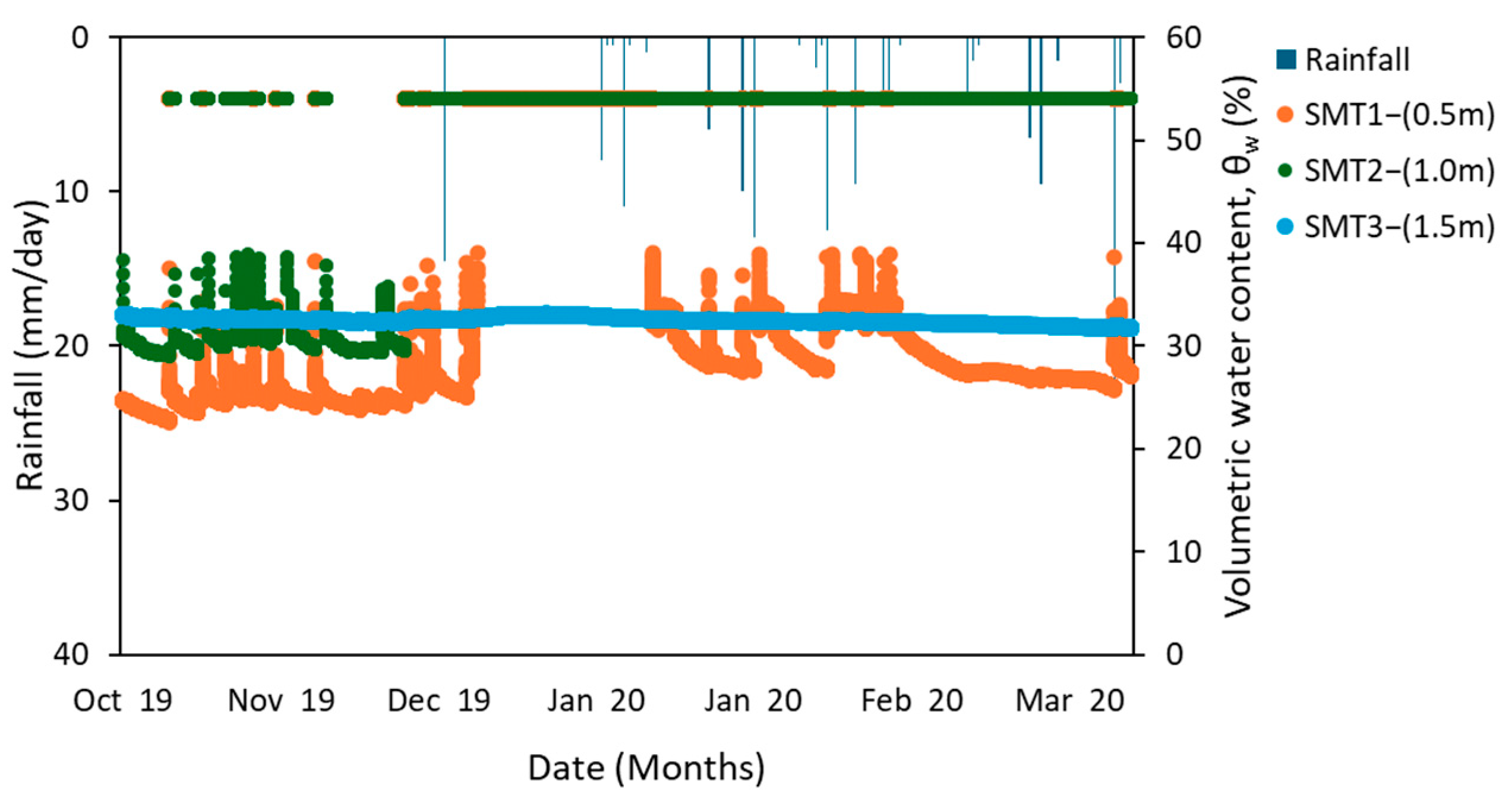

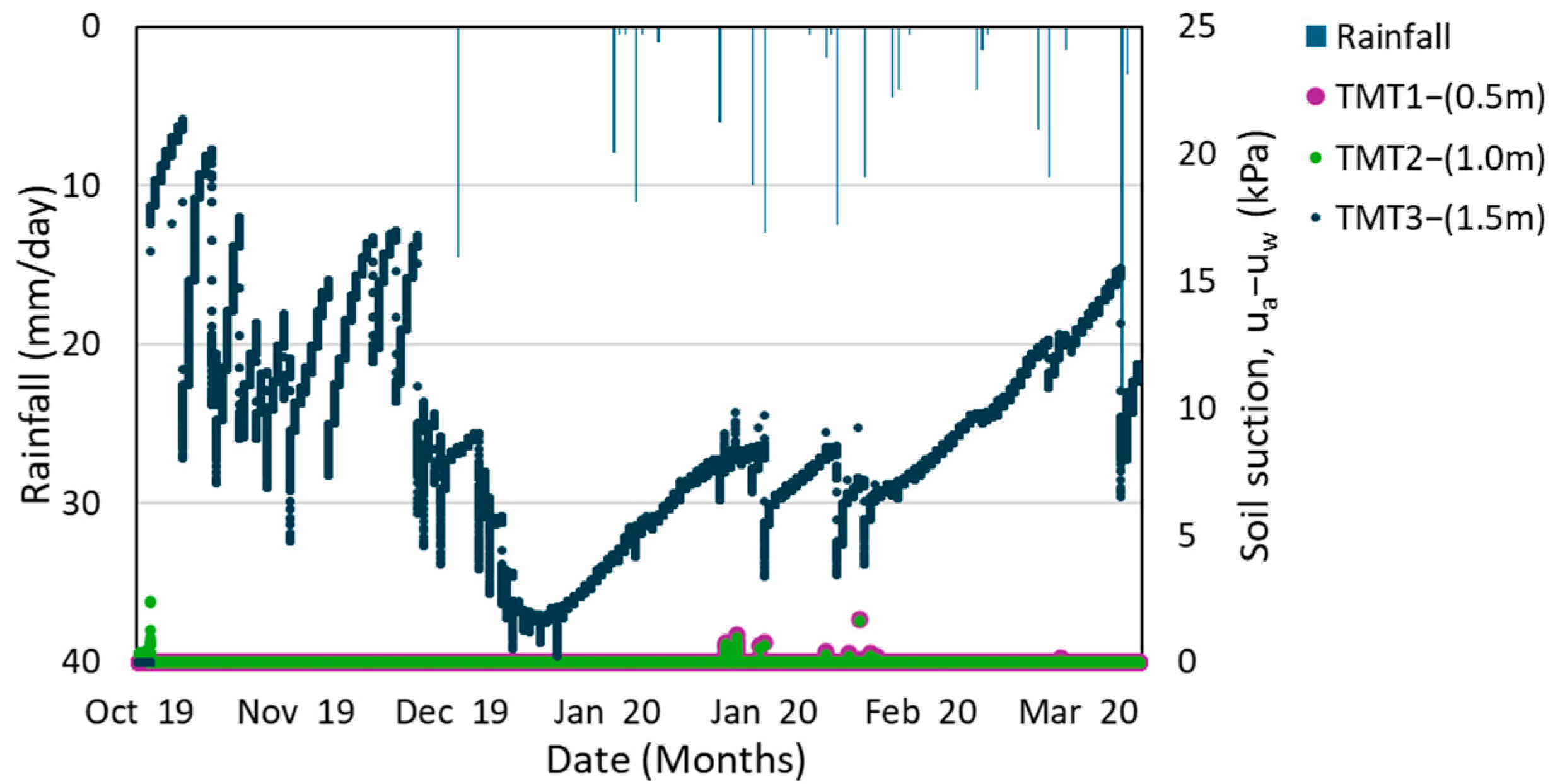
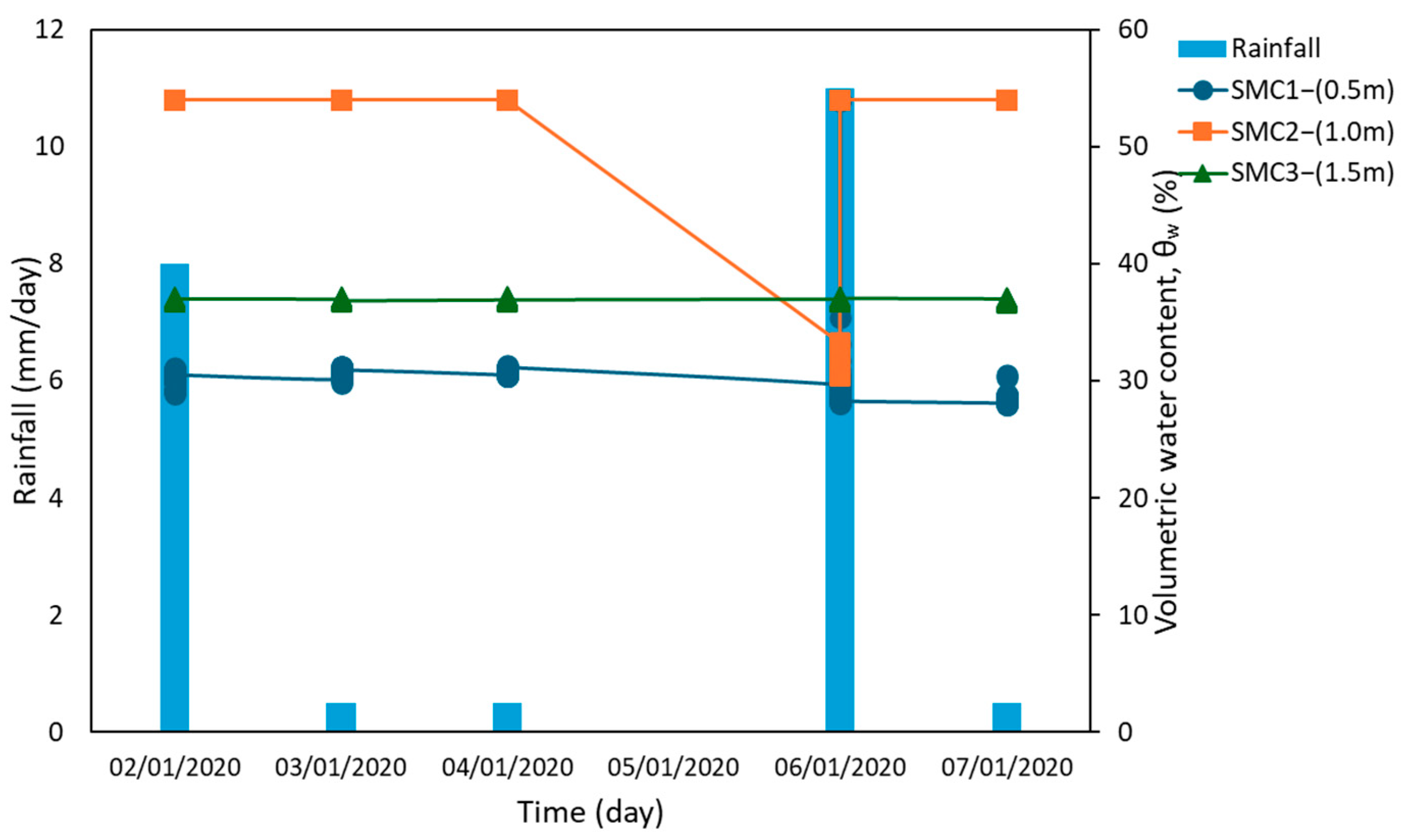
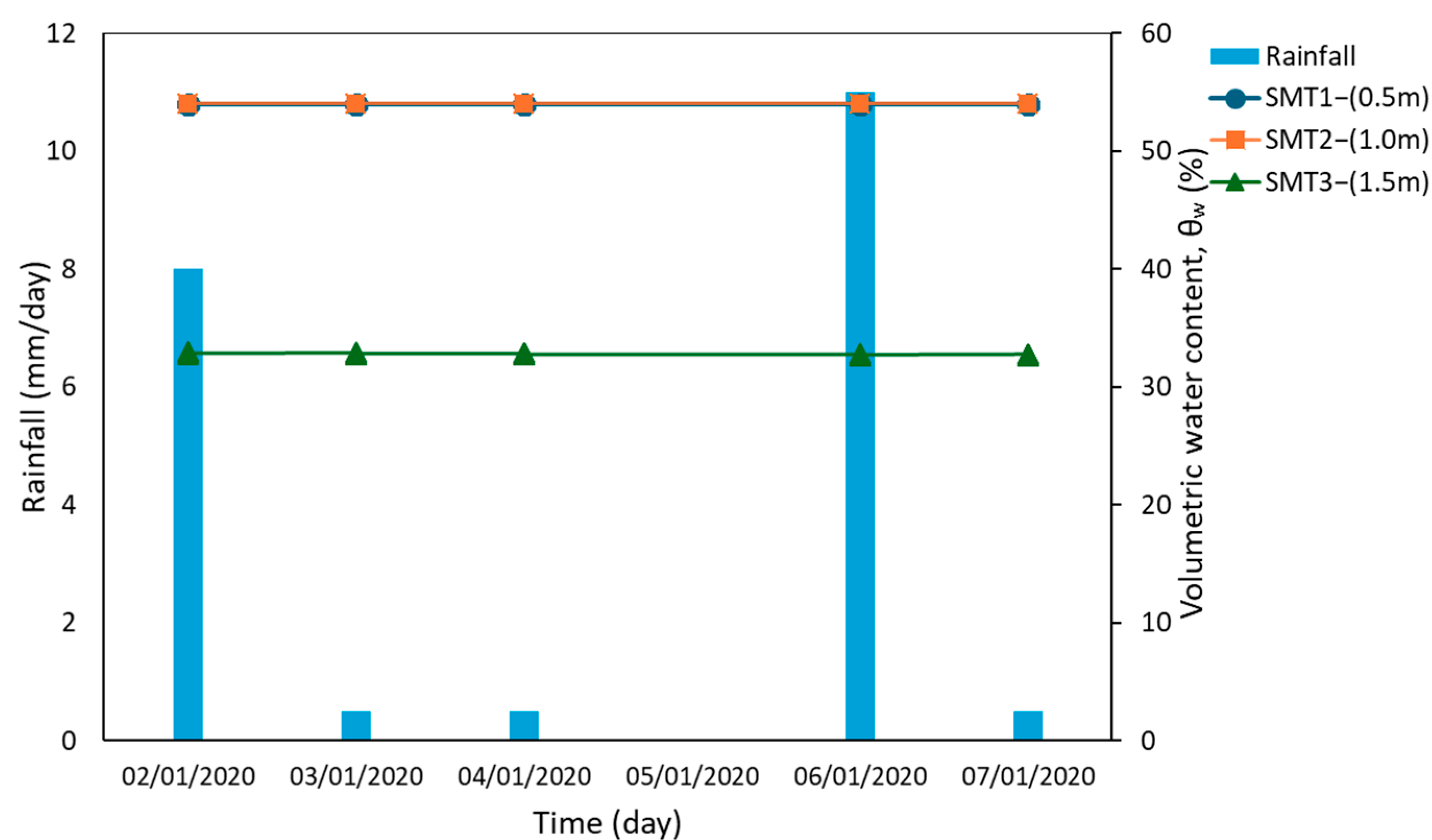
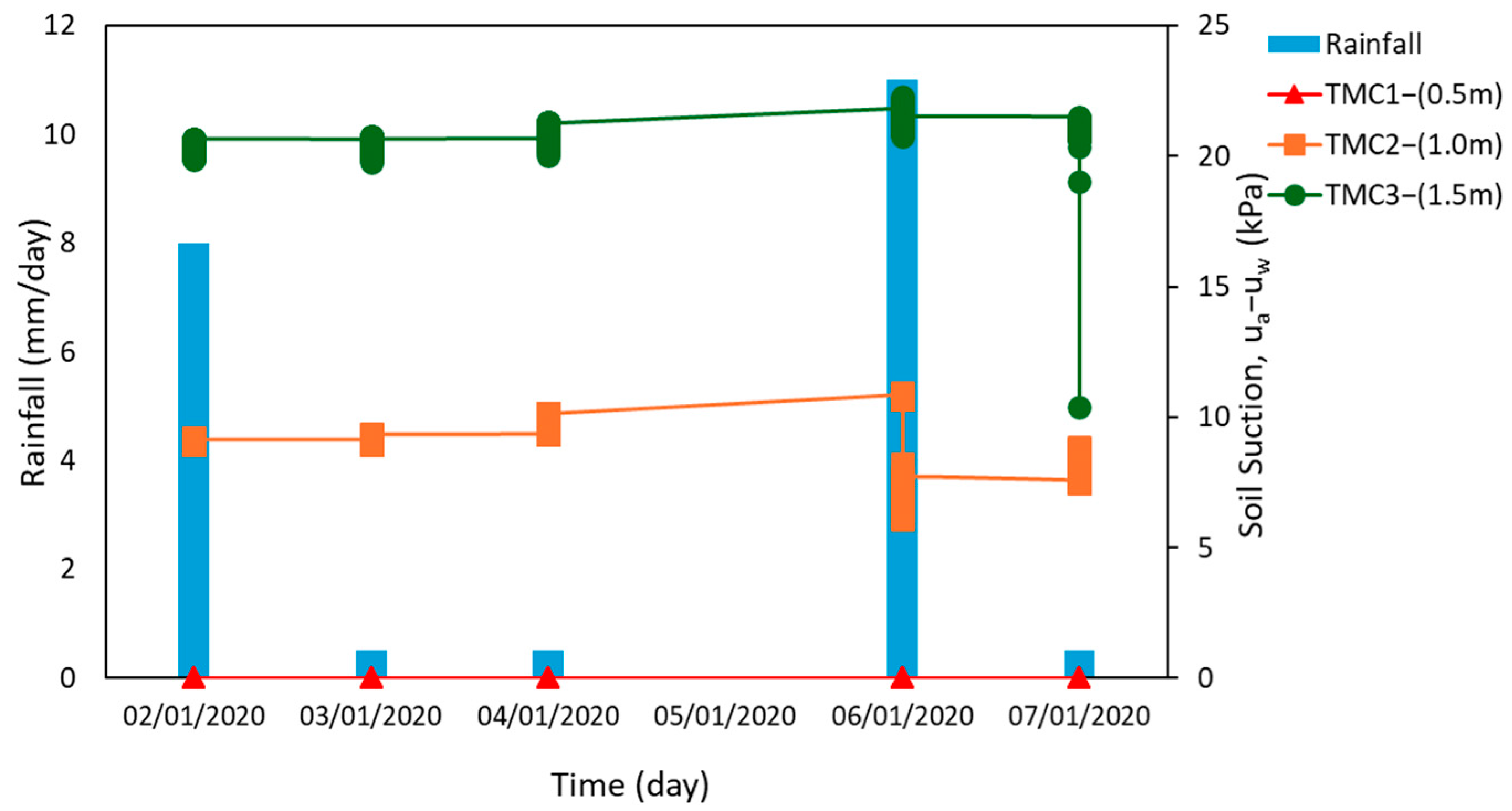

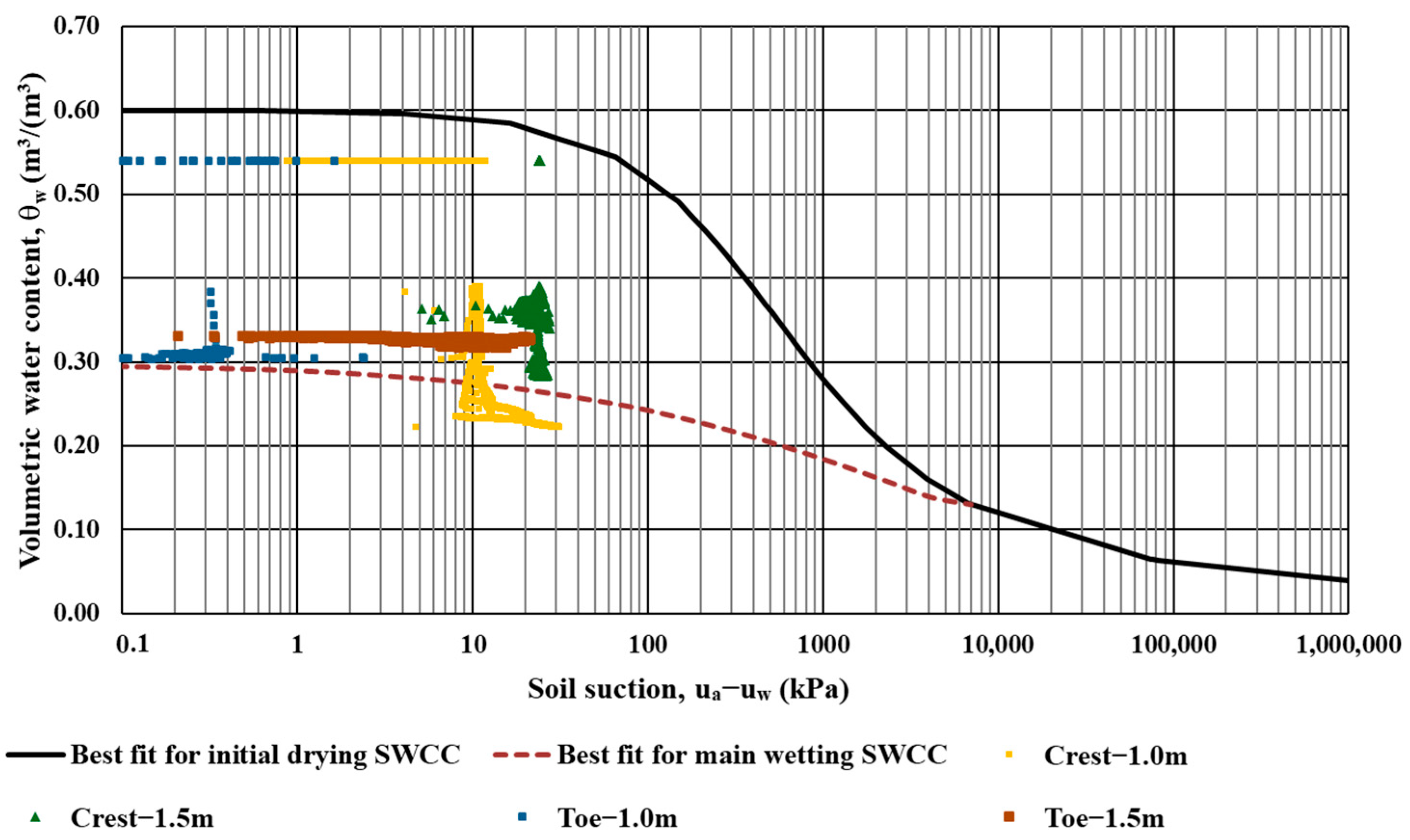
| Properties | Testing Standards | Value |
|---|---|---|
| USCS | ASTM D2487-17 [38] | CL |
| Gravel (%) | ASTM D422-63 [39] | 4 |
| Sand (%) | 45 | |
| Silt (%) | 17 | |
| Clay (%) | 34 | |
| Liquid Limit, LL (%) | ASTM D4318-17e1 [40] | 46 |
| Plastic Limit, PL (%) | 22 | |
| Plasticity Index, PI (%) | 24 | |
| Total density (Mg/m3) | 1.91 | |
| Water content (%) | 24.7 | |
| Void ratio | 0.65 | |
| Saturated Permeability, ks (m/s) | ASTM D5084-24 [41] | 2.65 × 10−6 |
| Parameter | Value |
|---|---|
| Saturated volumetric water content (θs) | 0.60 |
| a | 300 |
| n | 1.0 |
| m | 1.3 |
| Air-entry value, (kPa) | 40 |
| Residual volumetric water content ( | 0.12 |
| Residual soil suction, (kPa) | 5000 |
| Parameter | Value |
|---|---|
| Saturated volumetric water content (θs) | 0.30 |
| a | 5000 |
| n | 0.4 |
| m | 3.0 |
| Water entry value,(kPa) | 5000 |
| Volumetric water content related to (m3/m3) | 0.06 |
| Wetting saturation point, (kPa) | 40 |
Disclaimer/Publisher’s Note: The statements, opinions and data contained in all publications are solely those of the individual author(s) and contributor(s) and not of MDPI and/or the editor(s). MDPI and/or the editor(s) disclaim responsibility for any injury to people or property resulting from any ideas, methods, instructions or products referred to in the content. |
© 2025 by the authors. Licensee MDPI, Basel, Switzerland. This article is an open access article distributed under the terms and conditions of the Creative Commons Attribution (CC BY) license (https://creativecommons.org/licenses/by/4.0/).
Share and Cite
Daramola, A.M.; Satyanaga, A.; Adejumo, B.D.; Kim, Y.; Qian, Z.; Kim, J. Real-Time Scanning Curve of Soil–Water Characteristic Curve for Sustainability of Residual Soil Slopes. Sustainability 2025, 17, 1803. https://doi.org/10.3390/su17051803
Daramola AM, Satyanaga A, Adejumo BD, Kim Y, Qian Z, Kim J. Real-Time Scanning Curve of Soil–Water Characteristic Curve for Sustainability of Residual Soil Slopes. Sustainability. 2025; 17(5):1803. https://doi.org/10.3390/su17051803
Chicago/Turabian StyleDaramola, Abdulroqeeb Mofeyisope, Alfrendo Satyanaga, Babatunde David Adejumo, Yongmin Kim, Zhai Qian, and Jong Kim. 2025. "Real-Time Scanning Curve of Soil–Water Characteristic Curve for Sustainability of Residual Soil Slopes" Sustainability 17, no. 5: 1803. https://doi.org/10.3390/su17051803
APA StyleDaramola, A. M., Satyanaga, A., Adejumo, B. D., Kim, Y., Qian, Z., & Kim, J. (2025). Real-Time Scanning Curve of Soil–Water Characteristic Curve for Sustainability of Residual Soil Slopes. Sustainability, 17(5), 1803. https://doi.org/10.3390/su17051803









